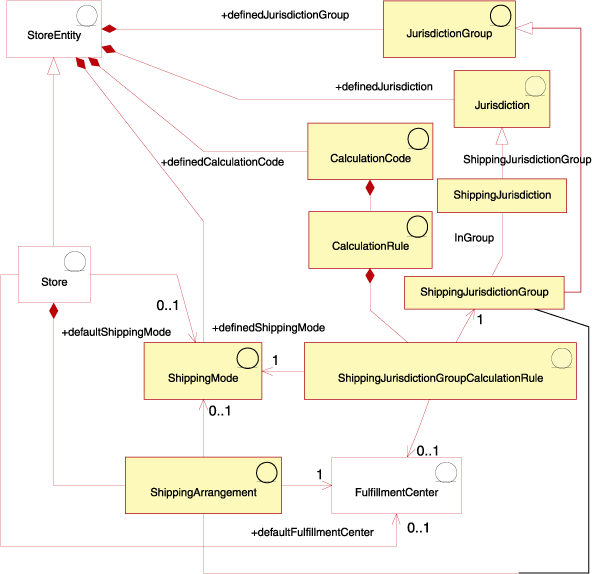Shipping assets
To offer shipping services, and charge for these services, a store that is created with WebSphere Commerce includes:
- At least one shipping mode
- At least one shipping calculation code
- Jurisdictions and jurisdiction groups
The following diagram illustrates the shipping structure in the WebSphere Commerce Server.

- Shipping modes
- The shipping mode is a way of shipping goods. A shipping mode is the
combination of a shipping carrier, and the shipping service that is offered by that carrier. A
shipping carrier is a company that provides shipping services from a fulfillment center to a
customer. For example, ABC Shipping Company, Overnight service and ABC Shipping Company, Express
delivery are shipping modes.
A shipping mode belongs to a store entity. If the store entity is deleted, the shipping modes that are defined within that store entity are also deleted. A store is not required to have a default shipping mode, but it is recommended.
- Shipping arrangements
- A shipping arrangement is an arrangement between the store and the
fulfillment center, indicating that a fulfillment center ships goods for a particular store with
specified shipping modes. Certain restrictions can be placed on a shipping arrangement, including
the time period for which the shipping arrangement is effective, and the shipping jurisdictions.
If a shipping arrangement is associated with a shipping mode, it applies only for that shipping mode. Otherwise, the shipping arrangement applies to all available shipping modes. A shipping arrangement is part of a store and is deleted if the store is deleted.
- Calculation codes
-
Calculation codes are used to calculate shipping charges, that is, a shipping
calculation code indicates how shipping charges are calculated for order items. To calculate
shipping charges on the order item, you must assign shipping calculation codes to either a catalog
entry or a group of catalog entries.
A calculation code is part of a store entity. A calculation code can be associated with only one store entity, but a store entity can have several calculation codes. If the store entity is deleted, the calculation codes that are associated with that store entity are also deleted.
- Calculation rules
- Each calculation code has a set of calculation rules. Shipping charges for an
order item can vary depending on the shipping mode, fulfillment center, and which shipping
jurisdictions.
ShippingJurisdictionGroupCalculationRulesare relationship objects that associate shipping calculation rules with jurisdictions, fulfillment centers, and shipping modes. These relationship objects determine which calculation rules are used for each order item.If the calculation rule, or any of the other objects that are referenced by the
ShippingJurisdictionGroupCalculationRules, is deleted, theShippingJurisdictionGroupCalculationrule is also deleted. - Jurisdictions and jurisdiction groups
-
Jurisdictions are geographical regions or zones that represents a country or
region, province or territory, or postal code range, to which you sell goods. Jurisdictions are
grouped to form jurisdiction groups.
WebSphere Commerce supports two types of jurisdictions: shipping jurisdictions and tax jurisdictions. Each of these jurisdictions is part of a corresponding group. For example, shipping jurisdictions are in the shipping jurisdictions group and tax jurisdictions are in the tax jurisdictions group.
Jurisdiction groups are associated with calculation rules. The calculation rule uses the jurisdiction group as part of the calculation to determine the shipping charge amount.
Jurisdictions and jurisdiction groups are part of a store entity. If the store entity is deleted, the jurisdictions and jurisdiction groups that are associated with that store entity are also deleted.
One shipping address can resolve to several shipping jurisdictions. For example, a shipping address in New York, United States applies to the following shipping jurisdictions: "New York, United States", "United States", and "World". When a shipping address applies to multiple shipping jurisdictions, several shipping calculation rules are applicable. In such cases, the precedence of the associated ShippingJurisdictionGroupCalculationRules is used to determine which rule or rules is used.